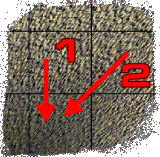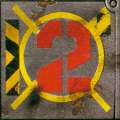
|
|
 Radio
Beam
Radio
Beam
 |
 |
Function: Robots moving into or through a Radio Beam receive
a remote move, which they have to use in their program for
the next turn. Robots do not get damaged by Radio Beams (but
can receive up to 2 remote programs per register phase).
The remote program is changed randomly every turn.
We recommend to use damage-tokens (upside-down) to keep
track of the distributed remote programs.
Timing: Like flamers, but active in all 5 register phases. |
|
|
 Repeater
Repeater

|
 |
 Reset
Site
Reset
Site
 |
 |
Function: A robots ending their move on a Repeater must execute
its current program card once again, if it is a MOVEMENT card
(Move 1, 2, 3 or Back up). If several robots are repeating
their movement cards, they are executed in normal priority
order. If the repetition let robots end on another Repeater,
another round of repeated maneuvers will occur.
Timing: Occurs after the Robots Move segment before entering
the next segment (and until no robot with a movement card
in its active register is on a Repeater).
Spindisc´s original element used here. |
|
Function: Like on Repair sites, robots can store there
archieve here (but neither repair nor exchange/gain options).
In addition, at the end of phases 1-4, the robot may choose
to replace his next programmed register (2.-5.) with a card
of his choice (that is still in pile). A robot ending on a
reset site at the end of the fifth register phase gains one
program card of his choice for the next turn (but replacing
one of his random cards - an undamaged robot receives 8 usually
dealt cards in addition to his free choice-card)
Timing: Allways (like Repair sites and Chop shops) |
|
|

 Rotating conveyor belts
Rotating conveyor belts

|
 |
Function: Every register phase, these belts rotate in position
indicated by the numbers on the belt. Then they behave exactly
like the normal belts of their colour. The arrows are used
to visualize the various directions, the belt may move to,
the actual direction changes each register phase.
Timing: Belts rotate in position at the beginning of the Board
Elements Move-Sequence.
This is our version of a belt transporting robots in more
than one direction (which is probably the most thought about
idea for a board element). There are lots of elements with
similar effects! |
|
|
 Rotating room
Rotating room

|
 |
Function: This time, the entire room rotates 90° CW every
turn. Rooms without robots in them do not rotate!
Timing: Rotation takes place in the End-of-Turn-Sequence. |
|
|
 Soporific Gas
Soporific Gas
 |
 |
 Sluice
Sluice
 |
 |
 Smoke
Smoke
 |
 |
 Smokestack
Smokestack
 |
 |
Function:A robot ending his move in a soporific gas cloud
immediately falls asleep.While sleeping, treat him as powered
down (regenerating damage).The robot keeps his unexecuted
movement cards of the current turn, because after five register
phases he awakes (more or less) refreshed to execute the rest
of his program. A robot ending after the second register
phase in a gas cloud, wakes up in the third register phase
of the next turn and executes his third, fourth and fifth
program card (remaining from the previous turn) like nothing
had happened.
Timing: Affects robot movement in the Robot move-Sequence
(in several turns). |
|
Function: Sluices have 2 states-open (in the picture)
and closed. Open sluices can be treated like open ground (robots
trying to move on an open sluice from the upper level fall
down, taking two p.o.d.) In the register phases indicated
by the numbers the sluice is closed. It can be treated like
open ground on the upper level (and behaves like a solid wall
on the lower level).
Timing: The sluice changes its state after program cards are
revealed before (!) robots move.
Robots standing on the sluice square when it closes get
killed immediately! |
|
Function:
Smoke blocks robots l.o.s (like fog, but stinking). As they
cannot see robots on the other site of the smoke, they don´t
fire weapons on them. A robot standing in a smoke square has
no l.o.s. at all (never fires). Smoke doesn´t effect
robots (or drones,...) movement.
Timing: Occurs when a robot moves into the smoke square or
has a l.o.s. at it (not through it). |
|
Function:
Smokestacks are ordinary pits (they are just rounder :). Smokestacks
emit smoke.
Timing: Always (it´s nothing but a bottomless pit).
Robots equipped with the tip-toe-legs option can enter
squares with smokestacks without falling in! |
|
|
 Soap
Soap

|
 |
 Spikey
Wall
Spikey
Wall
 |
 |
Function: Robots standing on soap will have their rotate cards
doubled. (U-Turns become 360s, normal rotate cards become
U-Turns)
Robots executing Movement cards on soap will have their first
square of movement negated.
Timing: Always |
|
Function: Robots running (or being pushed) against a spikey
wall receive one p.o.d.
Timing: Always |
|
|
 Start
Start

|
 |
[NO
IMAGE] Tamagotchi
 |
 |
Funktion: Defined and numbered starting positions for Race
Track-boards (and the Arena 2000-board). After the race started,
treat the square as a normal ground square.
Timing: At the very beginning of the game. |
|
Tamagotchis
aren´t really board elements, they move around like
drones,etc. They are impersonated by the robots virtual bot-tokens.
Every time a robot uses a copy machine,
a tamagotchi appears.
Tamagotchis are treated like virtual bots. They move by executing
the players program cards of the real bot that they belong
to. Tamagotchis cannot archive, but can tag flags, gain option,...
If either the Tamagotchi or the robot get killed, both
die immediately! |
|
|
 Tilted Ground
Tilted Ground

|
 |
Funktion: Every robot attempting to end its move on the sand
slips down one square (without changing the direction he is
looking in) In the corners of the crater, the robot slips
down diagonaly.
Timing: Affects robot movement in the Robot move sequence
as well as in the Board elements move-Sequence. |
|
|
 Trapdoor
Trapdoor

|
 |
Function: The figure indicates the number of robots, the trapdoor
can carry (in its 4 / 9 squares). If one more robot tries
to end his move on it, he sets of the trapdoor: It immediately
opens (killing all other robots on it) and the robot ends
his move being the only one on the (again) closed trapdoor.
Trapdoors can open/close several times in one register phase
depending on the robots moves and their priorities!
Timing: May occur in the Robots move-Sequence as well as in
the Board elements move-Sequence. |
|
|
 Turrent
Turrent

|
 |
 |
 |
 Ventilator
Ventilator
 |
 |
Function: Turrents are little weapons rising in the center
of a pit. They can rotate or shoot. After program cards are
dealt, pick 5 of the unused cards at random to determine the
behaviour of all turrents on the board. Rotate cards cause
the turrents to rotate, there is a special token to keep track
of the turrents´current position. A move card causes
the turrent to fire a (normal) laser beam.
Robots trying to enter a turrent´s square fall into
the pit. In all other aspects, turrents behave like a wall:
they block robots´ l.o.s. and weapons, they cannot be
destroyed or moved.
|
|
Timing:
The program cards for the turrents are revealed along with
the players´cards. The turrents then either rotate in
sequence C when the gears rotate or shoot in sequence D simultaneous
to the board-mounted lasers.
Variant rule: Turrents are armed with traktor and pressor
beams instead of ordinary lasers!
A move card cause them to push robots a number of squares
(1,2, or 3 according to the program card) or pull them 1 square
nearer to the turrent´s pit (in case the program card
was a back-up). |
|
Function:
Every robot ending its move in the line of a ventilator, gets
blown away. The number of squares it is moved is equal to
the number of ventilators that are connected in parallel (1
to 3).
Timing: Ventilators are active in the indicated register phases
in the board elements move-sequence. |
|
|
 Waterfall
Waterfall
 |
 |
Function:
Waterfalls transport robots like currents. But they also transport
the robot down one or more levels. For every level a robot
falls down, it takes 2 p.o.d.s.
Timing: Occurs in the Board-Elements_move-sequence (C) simultaneously
to the currents. |
|
|